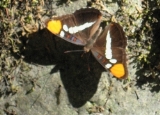
California Sister Butterfly
Encyclopedia
The California Sister (Adelpha californica), sometimes placed in the genus
Limenitis
), is a butterfly
of the family Nymphalidae
. The butterfly is named for its black and white markings on the forewing that resemble a nun's habit. It is commonly found on oak trees (on which it lays its eggs) and by water sources where it sips salts from the mud.
The California Sister is found in oak woodlands through much of California and western Oregon to extreme southern Washington. Recent phylogenetic studies confirmed that it represents a distinct species
from the sister butterflies found in southwestern Mexico (Mexican Sister, A. fessonia
), which it was previously included as subspecies
, as do those occurring from Utah and Colorado south through Arizona, New Mexico, Texas and Mexico to Guatemala
(Arizona Sister, A. eulalia)
(Limenitis lorquini). However, the California Sister has red spots on its forewings surrounded by black, whereas the Admiral has orange wing tips. It can also be distinguished by the small blue wing shaped patches with red centers on the front of the forewing. Its wingspan ranges from 1 to 3 inches.
Other similar butterflies are:
are used as larval host-plants.
Adults prefer fruit that has fallen from its source or has been pecked at by birds. They rarely sip nectar from flowers but occasionally use California Buckeye - (Aesculus californica) and Toyon - (Heteromeles arbutifolia)
flowers as food sources.
This species flies twice a year, from April to June and again from August to September.
Genus
In biology, a genus is a low-level taxonomic rank used in the biological classification of living and fossil organisms, which is an example of definition by genus and differentia...
Limenitis
Limenitis
Limenitis is a genus of brush-footed butterflies, commonly called the Admirals. The Sister butterflies and Commander butterflies are sometimes included here....
), is a butterfly
Butterfly
A butterfly is a mainly day-flying insect of the order Lepidoptera, which includes the butterflies and moths. Like other holometabolous insects, the butterfly's life cycle consists of four parts: egg, larva, pupa and adult. Most species are diurnal. Butterflies have large, often brightly coloured...
of the family Nymphalidae
Nymphalidae
The Nymphalidae is a family of about 5,000 species of butterflies which are distributed throughout most of the world. These are usually medium sized to large butterflies. Most species have a reduced pair of forelegs and many hold their colourful wings flat when resting. They are also called...
. The butterfly is named for its black and white markings on the forewing that resemble a nun's habit. It is commonly found on oak trees (on which it lays its eggs) and by water sources where it sips salts from the mud.
The California Sister is found in oak woodlands through much of California and western Oregon to extreme southern Washington. Recent phylogenetic studies confirmed that it represents a distinct species
Species
In biology, a species is one of the basic units of biological classification and a taxonomic rank. A species is often defined as a group of organisms capable of interbreeding and producing fertile offspring. While in many cases this definition is adequate, more precise or differing measures are...
from the sister butterflies found in southwestern Mexico (Mexican Sister, A. fessonia
Adelpha fessonia
The Band-celled Sister or Mexican Sister is a species of butterfly of the Nymphalidae family. It is found in Panama north through Central America to Mexico. It is a periodic resident in the lower Rio Grande Valley, Texas....
), which it was previously included as subspecies
Subspecies
Subspecies in biological classification, is either a taxonomic rank subordinate to species, ora taxonomic unit in that rank . A subspecies cannot be recognized in isolation: a species will either be recognized as having no subspecies at all or two or more, never just one...
, as do those occurring from Utah and Colorado south through Arizona, New Mexico, Texas and Mexico to Guatemala
Guatemala
Guatemala is a country in Central America bordered by Mexico to the north and west, the Pacific Ocean to the southwest, Belize to the northeast, the Caribbean to the east, and Honduras and El Salvador to the southeast...
(Arizona Sister, A. eulalia)
Description
The California Sister is similar in appearance to the Lorquin's AdmiralLorquin's Admiral
The Lorquin's Admiral is a butterfly from the Nymphalinae subfamily. The butterfly is named after Pierre Joseph Michel Lorquin, a French naturalist who came to California from France during the Gold Rush and made important discoveries on the natural history of the terrain.-Physical description:The...
(Limenitis lorquini). However, the California Sister has red spots on its forewings surrounded by black, whereas the Admiral has orange wing tips. It can also be distinguished by the small blue wing shaped patches with red centers on the front of the forewing. Its wingspan ranges from 1 to 3 inches.
Other similar butterflies are:
- White Admiral (L. a. rubrofasciata)
- Weidemeyer's Admiral (L. weidemeyeriiLimenitis weidemeyeriiThe Weidemeyer's Admiral is a butterfly from the Nymphalinae subfamily, in western North America.-Distribution:...
)
Ecology
California Oaks (Quercus species)California oak woodland
California oak woodland is a plant community found throughout the California chaparral and woodlands ecoregion of California in the United States and northwestern Baja California in Mexico...
are used as larval host-plants.
Adults prefer fruit that has fallen from its source or has been pecked at by birds. They rarely sip nectar from flowers but occasionally use California Buckeye - (Aesculus californica) and Toyon - (Heteromeles arbutifolia)
Toyon
Heteromeles arbutifolia , and commonly known as Toyon, is a common perennial shrub native to California down to Baja California....
flowers as food sources.
This species flies twice a year, from April to June and again from August to September.

